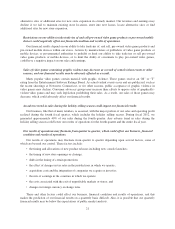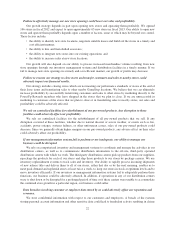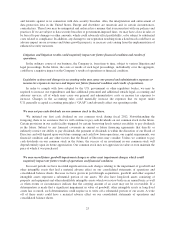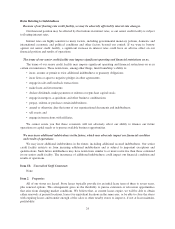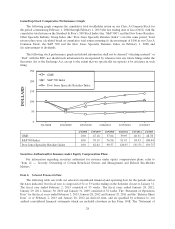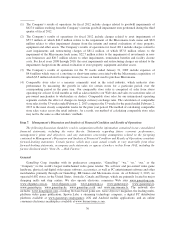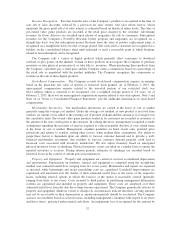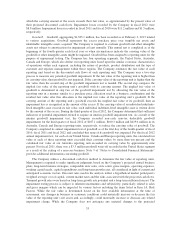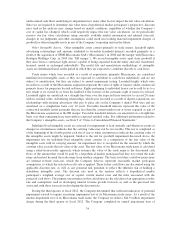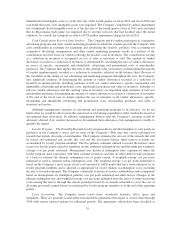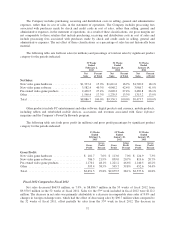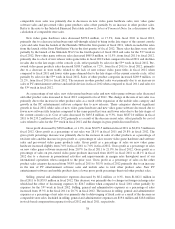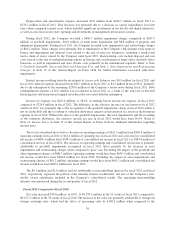GameStop 2012 Annual Report Download - page 46
Download and view the complete annual report
Please find page 46 of the 2012 GameStop annual report below. You can navigate through the pages in the report by either clicking on the pages listed below, or by using the keyword search tool below to find specific information within the annual report.Our fiscal year is composed of 52 or 53 weeks ending on the Saturday closest to January 31. The fiscal year
ended February 2, 2013 (“fiscal 2012”) consisted of 53 weeks. The fiscal years ended January 28, 2012 (“fiscal
2011”) and January 29, 2011 (“fiscal 2010”) consisted of 52 weeks.
Growth in the electronic game industry is generally driven by the introduction of new technology. Gaming
consoles are typically launched in cycles as technological developments in both chip processing speeds and data
storage provide significant improvements in advanced graphics, audio quality and other entertainment
capabilities beyond video gaming. The current generation of consoles (the Sony PlayStation 3, the Microsoft
Xbox 360 and the Nintendo Wii) were introduced between 2005 and 2007. The Nintendo DSi XL was introduced
in early 2010, the Nintendo 3DS was introduced in March 2011 and the Sony PlayStation Vita was introduced in
February 2012. A new console cycle is developing as Nintendo launched the Wii U in November 2012 as the
next generation of the Wii. Also, Sony has announced that the next generation of the PlayStation will come to
market by the holiday period of 2013. Microsoft has not formally announced definitive plans to introduce a new
console. Typically, following the introduction of new video game platforms, sales of new video game hardware
increase as a percentage of total sales in the first full year following introduction. As video game platforms
mature, the sales mix attributable to complementary video game software and accessories, which generate higher
gross margins, generally increases in the subsequent years. The net effect is generally a decline in gross margins
in the first full year following new platform releases and an increase in gross margins in the years subsequent to
the first full year following the launch period. The planned launch of the next-generation Sony PlayStation by the
holiday period of 2013 will negatively impact our overall gross margin in that quarter and in future years. Unit
sales of maturing video game platforms are typically also driven by manufacturer-funded retail price reductions,
further driving sales of related software and accessories. Historically, new hardware consoles are typically
introduced every four to five years. However, the current generation of hardware consoles is now over six years
old and consumer demand is declining. We have seen declines in new hardware and software sales in fiscal 2012
due to the age of the current console cycle. The introduction of new consoles, like the Wii U, or further price cuts
on the current generation of consoles could partially offset these declines.
We expect that future growth in the electronic game industry will also be driven by the sale of video games
delivered in digital form and the expansion of other forms of gaming. We currently sell various types of products
that relate to the digital category, including digitally downloadable content, Xbox LIVE, PlayStation and
Nintendo network points cards, as well as prepaid digital and online timecards. We expect our sales of digital
products to increase in fiscal 2013. We have made significant investments in e-commerce, digital kiosks and in-
store and Web site functionality to enable our customers to access digital content easily and facilitate the digital
sales and delivery process. We plan to continue to invest in these types of processes and channels to grow our
digital sales base and enhance our market leadership position in the electronic game industry and in the digital
aggregation and distribution category. In fiscal 2011, we also launched our mobile business and began selling an
assortment of tablets and accessories. We currently sell tablets and accessories in all of our stores in the
United States and in a majority of stores in our international markets. We also sell and accept trades of pre-
owned mobile devices in our stores. In addition, we intend to continue to invest in customer loyalty programs
designed to attract and retain customers.
Critical Accounting Policies
The Company believes that the following are its most significant accounting policies which are important in
determining the reporting of transactions and events:
Use of Estimates. The preparation of financial statements in conformity with accounting principles
generally accepted in the United States of America (“GAAP”) requires management to make estimates and
assumptions that affect the reported amounts of assets and liabilities, the disclosure of contingent assets and
liabilities at the date of the financial statements and the reported amounts of revenues and expenses during
the reporting period. In preparing these financial statements, management has made its best estimates and
judgments of certain amounts included in the financial statements, giving due consideration to materiality.
Changes in the estimates and assumptions used by management could have significant impact on the
Company’s financial results. Actual results could differ from those estimates.
31


